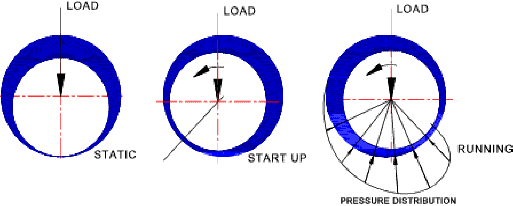| A friction bearing consists of a fixed,
non-moving bearing surface, such as machined metal or
pressed-in bushing, that provides a low-friction support
surface for rotating or sliding surfaces. Friction bearings
commonly use lubricating oil to separate the moving
component from the mated non-moving bearing surface.
Friction bearing surfaces commonly consist of a material
that is softer than the supported component. Friction bearings, because of their soft consistency, have the ability to embed foreign matter to prevent spreading in the engine. Friction bearings also have the ability to conform to slightly irregular mating surfaces. Friction bearings can be integrally machines, one-piece sleeve, or split-sleeve for easy installation and removal. |
| Working principal of friction bearing |
| Videos |
|
In hydrodynamic bearings, the gap is generated dynamically
by the bearing motion. Hydrodynamic bearings are used in
rotary applications, and may require external pressure on
one of the bearing pads or a secondary bearing to avoid
excess friction when starting rotation. Hydrodynamic
bearings can be designed for radial or thrust loads. A hydrodynamic bearing is typically a low-clearance assembly that relies on a film of oil (and occasionally air) that develops space while the spindle is rotating. The bearings transmit (float) the load on self-renewing film of lubricant. The most basic hydrodynamic bearing is the journal bearing. It has a cylindrical bore, typically with two axial grooves for lubrication. This bearing has a high load capacity and the simple design is compact, bi-rotational, and easy to manufacture. As the design speeds of machines increased, it was found that this bearing had limitations requiring modifications. |
|
|
|
Hydrostatic bearings are externally pressurised fluid
bearings, where the fluid is usually oil, water or air, and
the pressurization is done by a pump.
Hydrostatic bearings are bearing systems that, because they are extremely precise and almost wear-free, are used especially in high-precision applications in measuring, testing and machine tool engineering. Hydrostatic bearings are also used in large steam turbines where pressure must first be established to ensure turbine shaft already are elevated by oil pressure. Oil pressure are maintained after shutdown to ensure effective cooling of bearings system |
| Friction bearings materials and properties |
| A common plain bearing design utilizes a hardened and polished steel shaft and a softer bushing. The bushing is replaced whenever it has worn too much. - Detail |
| Type of friction bearings |

TVET COLLEGE SUPPORT
BEARINGS
Friction bearings
